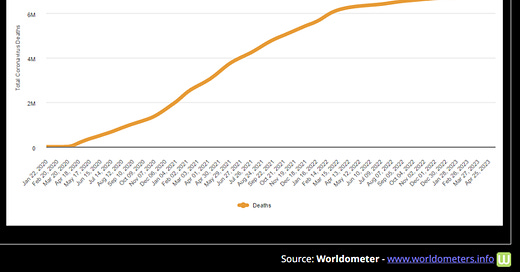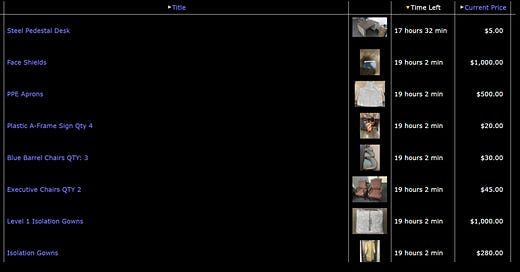
Why were the infection rates double and death rates 36% higher amongst those on maintenance dialysis during the first Omicron wave compared to Delta?
The CDC is out with a new report.
CDC - “during June 30, 2021–September 27, 2022, rates of SARS-CoV-2 infection and COVID-19–related death were higher among maintenance dialysis patients compared with rates in the U.S. population. These higher infection rates were attenuated by vaccination”.
Maintenance dialysis = treatment for kidney failure.
Presumably other studies exist that cover the period prior to 30 June 2022, so infection rates during different C19 variant waves can be compared to a period when no C19 injections were administered.
From here:
“Patients receiving maintenance dialysis benefit from staying up to date with recommended COVID-19 vaccination. Continued efforts to mitigate transmission of respiratory viruses in dialysis facilities are warranted.”
Oh. C19 injections were effective. Okay let’s dig a little deeper and FIRST check out the limitations listed:
“First, this report included data submitted by outpatient facilities to NHSN. Although the dataset included over 90% of the estimated total maintenance dialysis patients in the United States (1), patients receiving inpatient dialysis, home hemodialysis, and peritoneal dialysis might be underrepresented in this analysis.
Second, facilities self-report data to NHSN, which might limit the validity of the information submitted.
Third, the NHSN definition of a COVID-19–related death was not limited to a death in which COVID-19 was listed as a cause of death on the death certificate or one that occurred during a specific time frame after COVID-19 infection. Therefore, it is possible that some deaths were misclassified as COVID-19–related deaths, resulting in an inflated COVID-19–related death rate.
Fourth, NHSN received aggregate facility-level data. Therefore, death rates could not be calculated by vaccination status, nor could patient-level covariates, including time since vaccination, previous COVID-19 infection, age, ethnicity, or comorbidities that play a role in the high death rate of patients receiving dialysis be considered.
Finally, this analysis did not account for differences in COVID-19 testing and reporting between dialysis patients and the U.S. population. It is possible that a higher rate of COVID-19 testing among dialysis patients (9) might have affected the results.”
Just those five limitations – no others. I wonder if there are any errors of omission, I think we can assume there were no errors of commission (an issue with growing significance amongst ALL C19 reporting by the CDCFDA – errors of omission AND commission!)
The third limitation – “possible that some deaths were misclassified”. I wonder how many co-morbidities sufferers requiring mainte4nance dialysis also had – caused by the condition or otherwise.
Check out the fourth limitation and compare that with claims of efficacy = see below.
No indication of how many patients were treated with Remdesivir in the 15 months ended September 2022 covered by the study.
Remdesivir “(run death is near”) has only just been fully approved for treatment in patients with renal failure on 14 July 2023.
FDA Approves Remdesivir for COVID-19 in Patients With Severe Renal Impairment (pharmacytimes.com)
“The FDA has approved remdesivir (Veklury, Gilead) for the treatment of COVID-19 in patients with severe renal impairment, including those on dialysis, making it the first approved antiviral treatment for patients across all stages of renal disease”.”
No indication of any the C19 mRNA injections CAUSING C19 infections with the SARS-COV2 virus – the spike protein is what causes the C19 diseases or is it not? “Spike protein from SARS-COV2 is supposed to equal Spike protein manufactured by the bodies immune system?”
Ok, here are claims of vaccine efficacy subject to the fourth limitation listed above:
“The overall incidence of SARS-CoV-2 infection among unvaccinated dialysis patients was 39.64 per 10,000 patient-weeks, compared with 27.24 per 10,000 among those who had received a complete primary COVID-19 vaccination series (Table). “
So, an initial course of injections resulted in a 31% reduction in SARS-COV2 infections over the full 15-month period ending September 2022.
“During the first and second Omicron waves (October 27, 2021–March 22, 2022), the overall infection rate among dialysis patients who had received ≥1 monovalent booster dose was 30.62, compared with 33.69 among vaccinated patients who had not received a monovalent booster dose.”
Getting a booster reduced infection rates by 9%.
“During the Delta and first Omicron waves, the infection rate among vaccinated patients was lower than that among unvaccinated patients (Figure 1), and during the first Omicron wave, the infection rate was lower among patients who had received a monovalent booster dose than among those who had not.”
C19 injections were effective in reducing infections – but to repeat the fourth limitation of the study “, NHSN received aggregate facility-level data. Therefore, death rates could not be calculated by vaccination status, nor could patient-level covariates, including time since vaccination, previous COVID-19 infection, age, ethnicity, or comorbidities that play a role in the high death rate of patients receiving dialysis be considered.”
To me, the a significant data point is the infection and fatality rates (with most patients double dosed and boosted?) for the first Omicron wave.
Note the 46.45 infections per 10,000 patient-weeks for the first Omicron wave – defined as between October 27, 2021–March 22, 2022 and also the death rate of 2.66.
(Monovalent booster dose vaccination data were only available during first and second Omicron waves (October 27, 2021–September 27, 2022).
The first Omicron wave resulted in more than twice as many infections and 36% more deaths than Delta????
This is a complete inverse of the experience of the general population – suggesting that a unique factor was at play for those on maintenance dialysis.
Onwards
Please upgrade to paid, or donate a coffee (I drink a lot of coffee) - “God Bless You!” if you can’t or don’t want to contribute. Coffee donations here: https://ko-fi.com/peterhalligan Buying just one Ko-Fi a week for $3 is 50 bucks more than an annual $100 subscription!












